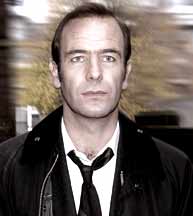Upon moving to Austin, Texas, I dutifully put the movie
Slacker in my Netflix queue. After all, a cult movie aficionado can hardly move to a new town with a renowned cult movie all its own without having seen that picture, right? Especially if that picture received a
presitigious Criterion two-disc release. With a screening of the DVD under my belt, I would be prepared for that inevitable moment when someone in Austin, upon learning of my interest in cinema, would ask:
"You like movies? Have you seen
Slacker? It was filmed here in Austin, you know."
The disc arrived in Austin shortly after I did, and then it sat atop my TV for three months. (My turnover rate for Netflix discs has always been woefully low, but I still feel certain that my occasional spurts of rental activity have justfied the monthly fees as compared to a local rental store and the late fees I cannot escape.) The activities of moving, telecommuting to do business with my old job, and looking for a new job, not to mention the business of Stomp Tokyo, kept me from putting the disc in the player.
But finally enough was enough and, after a day of piling through receipts and electronic bank records to complete our 2004 income taxes (what do you mean, "we owe the government money?"), Christina and I decided to treat ourselves to one Austin institution (
Saccone's pizza) while watching another. Thus our journey with Richard Linklater (the man who, over a decade later, would direct the highly entertaining
School of Rock) and the slackers of early '90s Austin began.
Ninety-eight minutes and a sausage-and-onion thin-crust pizza later, I was left trying to come up with a polite answer to that question above that wouldn't offend anyone.
Slacker, for reasons that pass my current understanding, was critically hailed as a masterpiece of (depending on which critic you read) surrealism, satire, and
cinema verité. Most of the reviewers simply seem relieved to be watching something that doesn't adhere to rigid Hollywood formula. I can appreciate that, but as someone who watches the film from the perspective of fourteen years of "independent" filmmaking later, it comes across as less innovative and more annoying.
The movie tells no particular story, drifting instead between several dozen of the most boring and uncomfortable conversations imaginable. There are two different aggressive conspiracy theorists (one JFK, one fake-space-program) who attach themselves to their victims with a frightening tenacity, a burglar who finds himself ensnared in a conversation about history and politics when his victim arrives home early, and a host of pseudo-intellectual twenty-somethings who occupy themselves with half-baked analyses of the cartoons of their childhood. In short, it's like the dark corners of a metropolitan public library combined with the more drunken moments of a lazy college honor student. If you've never experienced these things in life, you might find
Slacker entertaining for about a third of its running time. If you have had the misfortune to encounter these people in person (or worse, you recognize some part of yourself in the characters), then you'll realize almost immediately that you've spent enough time trying to extricate yourself from actual social situations like these, and you'll wonder why anyone would want to watch it on film.
None of these vignettes are filmed or acted with particular aplomb – they just sort of
are, and oftentimes they're much less convincing than would be their real-life counterparts. There's an uncomfortable situation, and then there's the filmic recreation of an uncomfortable situation that manages to throw in some additional tedium. About an hour into the picture,
Slacker assumes the perspective of a character in a bar with a toy
Pixelvision camera. This prompted my wife to observe that "up to this point it's just been boring. Now it's boring with bad video."
Apart from the title, there is some indication that Linklater is aware of the the film's deadly realism. A self-professed "anti-artist" (Austin musician "Wammo") confesses that he does little besides work in a bar, eat, sleep and watch movies. Few of the self-important posers are portrayed as being much more than that. The question is: why immortalize these people, these conversations? Is it much more than a fledgling filmmaker learning his craft and gathering material for the soon-to-follow (and genuinely funny)
Dazed and Confused?
Whatever the answer, I'm glad that Linklater moved on to better material and made better pictures. If the idolization of an imperfect work (a
two-disc Criterion release?
really?) is the price we pay for the rest of Linklater's catalog, then I suppose I'm okay with that.
Just don't expect me to give you the "
Slacker tour" of Austin when you come to visit.
 Even the digital magic of DVD hasn't much changed the fuzzy nature of advance bootleg screeners -- instead of peering through fuzzy VHS degradation, I was trying to penetrate blocky MPEG compression. The more things change, the more they stay the same, right?
Even the digital magic of DVD hasn't much changed the fuzzy nature of advance bootleg screeners -- instead of peering through fuzzy VHS degradation, I was trying to penetrate blocky MPEG compression. The more things change, the more they stay the same, right?

